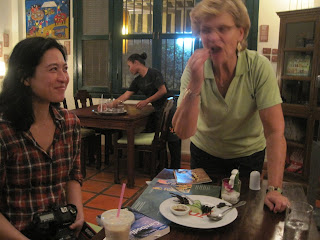Read more about this horrific time 1975-1979 in books by Loung Ung; Lucky Child and First They Killed My Father. This child warrior who lived through the atrocities of the Khmer Rouge – not that long ago – tells the story of how her indomitable spirit triumphs over the tyranny she and many other people like us faced. In her author’s note she says:
“From 1975-1979 – through execution starvation, disease, and forced labor – the Khmer Rouge systematically killed an estimated 2 million Cambodians, almost ¼ of the country’s population….though these events constitute my experience, my story mirrors that of millions of Cambodians. If you had been living in Cambodia during this period, this would be your story, too.”
Feeling a gentle breeze and sun on my shoulders, I listen to birds chirp as our guide who was born in 1975 describes this recent history. I see one survivor who comes to the museum every day to tell the school children his story. I witness the chambers of horror were so many people suffered. Of the 7 prisoners and 5 children who survived, two are artists. The paintings they painted hang demonstrating as only paintings can, what really happened here. Tears well up in my eyes. I do not allow the tears to fall. Somehow I feel the strength of the innocent. I must focus on the life beyond the killing here and also later when we go to the Killing Fields.
We drive by bus about 30 minutes along busy roads out beyond rice fields, farm fields, and small shops. We arrive at the spot where those who were not murdered at the converted school came to be executed and deposited into mass graves. A huge tower full of skulls is a monument to their courage. With my deep sadness I pause to feel the flutter of the butterflies who love this commemorated place. This is all I can write now. My heavy heart aches for what my fellow human beings endured – people just like me.
On the bus ride back our guide lightens out spirit by teaching us to speak Cambodian – every word seems to have my name in it! We eat lunch on a balcony overlooking the river. A tour of the Royal Palace and Silver Pagoda give delightful distraction. Judy and I also tour the national museum identifying many Buddhas and statues of mystical mythical magical realms form the 6th century and beyond – both ways!
Judy and I find out ‘romork ‘ driver ( motorized rickshaw). We fly through the crowded streets to enjoy another go at the central market. Ha ha - we are helping the Cambodian economy is a small way! Judy joins a line dance yelling at me to join her – but , hey! I am holding on to all the bags in this haven for pick-pocket - ers. (Is that a word?)
Our guide, Vantha, tells us Phomh Penh is a city of “heaven and hell”. That is what our day was like.
































